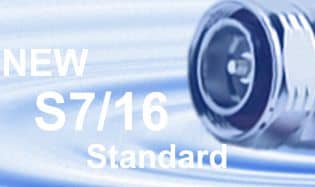The ubiquitous 7/16 connector standard
The ubiquitous 7/16 connector standard, so often criticised by Hughes Electronics, which resulted in generations of ill fitting, poor quality connections and a great deal of the Passive Inter-Modulation in cellular networks has recently had a change of fortunes in the shape of the S7/16 standard.
 But who’s heard of it?
But who’s heard of it?
The hugely improved 7/16 connector standard introduced last year by CENELEC has this year filtered down to our own BS EN61169-53:2016, unfortunately networks and equipment manufacturers seem to be oblivious to it’s existence and to the potential for savings it offers them.
So what is it?
Essentially designed as a test interface standard S7/16 inherits interface dimensions from it’s its older brother, where 7 refers to the dimensions of the inner contact (7mm)and 16 refers to the dimensions of the outer contact (16mm) but with a 0mm manufacturing tolerance on the inner conductor and only +/- 0.20mm manufacturing tolerance on the outer conductor the dimensional tolerances of the S7/16 are much stricter.* The female inner contact has been given a much improved indented ‘spring collar’ too, much like our own WaveWay connector design which provides better surface adhesion on the forward path and improves signal throughput, reduces resistance, reflections and losses.
*Loose dimensional tolerancing was one of the basic flaws of the 7/16 connector.
Its compact too
It doesn't stop at better performance either, the S7/16 seems to satisfy the demand for space that drove the much anticipated revival of the 4.3/10 at the antennae interface too. The male locking nut has been reduced in size from M29 to M22 making it a direct, and in the view of Hughes Electronics, better competitor to the 4.3/10 which is only very slightly smaller at M20.
So whats the downside?
Hughes research shows that metal is a poor material of choice for the construction of connectors intended for use in next generation cellular networks (white paper) and in our view there is room for a family of two standards, both with the same dimensional interfaces one with the M29 nut and one with the M20. Clearly the missed opportunity was to retain the M29 coupling thread to make the S7/16 backwards compatible to the 7/16, a simple move that could have saved networks £millions in swap outs of perfectly good feeder connections and equipment.
4.3/10 vs S7/16
There is no doubting that Hughes Electronics WaveWay is the superior Connector for 4G and next generation cellular applications (white paper) but if a provider is set on deploying metal connectors then the S7/16 interface is the clear winner, with greater power and frequency handling than the 4.3/10 it offers the opportunity of a balanced channel with residual 7/16 connections.
Why are networks showing no interest?
Who knows, where one network leads others follow, perhaps the network Guru who decided that the 4.3/10 was the solution to the networks transmission problems doesn’t want to admit to yet another mistake? But networks should take a step back
The Hybrid is Born
Hughes Electronics are developing a limited number of S7/16 interfaces for their own test and measurement use albeit with an M29 male locking nut in order to provide better test results and compatibility with our existing equipment.


